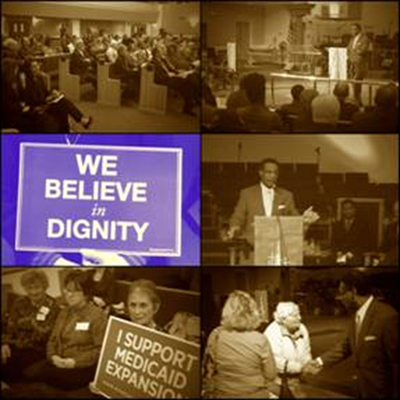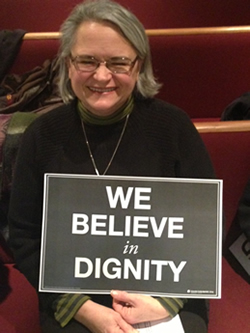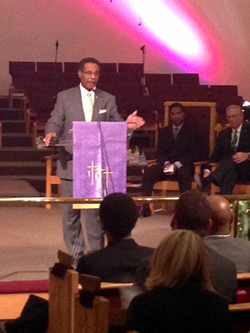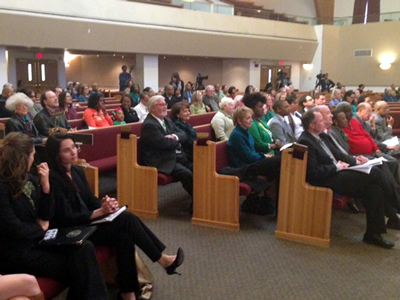EC from DC - March 21, 2014
This week I was pleased to announce that our collaborative and hard-fought efforts here at home, and in Washington, have paid off. Kansas City got two big wins this week! One of them is a critical move forward in getting back on the list for funding to fight everything from terrorism to tornadoes.
Securing federal funds to keep the metropolitan area at the forefront of emergency preparedness is critical. We need to make sure we are equipped with the best talent, training, and techniques, if disaster should strike.
The United States Department of Homeland Security’s Federal Emergency Management Agency announced its list of cities receiving grants this week. The awards are for the State Homeland Security Program, and the Urban Areas Security Initiative (UASI).
After getting ZERO dollars last year under UASI, Kansas City will receive $1,000,000 this fiscal year.
And Missouri has been awarded almost $4 million dollars ($3,978,000) for fiscal year 2014 for our State Homeland Security Program. That’s an increase of almost a half of a million dollars over last year’s allocation of $3,459,364.
It is an astounding victory for the city and the entire metropolitan region.
The Kansas City UASI Region is made up of:
- 2 states
- 8 counties
- 116 cities
- 3,800 square miles
- 1.9 million people
- Is the 2nd largest rail hub in the region
- Is the 3rd largest trucking center
- Has multiple agricultural and bioscience centers
As you know, the threats we face continue to grow in number and complexity. Our law enforcement officers and first responders are doing all they can to be prepared, and we must do all we can to fight for them. These grants make a dramatic difference.
Goals Include:
- Better communication between emergency rescuers, law enforcement, hospitals, and others
- Sharing more information, analysis, and research to more efficiently anticipate, prevent, and respond to crises
- Training and equipment for specialized response teams including hazmat, rescue and explosive teams
- Investment in technology to more quickly identifies disease outbreaks
- Enhancing systems to communicate emergency warnings to the public, operate emergency centers, and increase overall awareness
I am thrilled our area will get the richly deserved funding we need to help make our community a safer place. And make no mistake, I will continue to work to make sure we get what we need to help, not hamstring, our police officers, firefighters, first responders, and all others dedicating themselves to these unbelievably challenging jobs. They must be armed with the best to help get us through the worst.
 |
It's not just a medical issue, it's a moral one. This week I joined Missouri Governor Jay Nixon and other state and community leaders leaders to push for the expansion of Medicaid in our state.
Why?
Because it is the right thing to do.
 |
What else would it do?
- It would close the Coverage Gap.
- It would mean almost 300,000 low-income adults throughout the state would get access to health care.
- It would mean our Missouri tax dollars would be used for Missouri residents instead of going to the other 26 states and the District of Columbia that have already opted to expand.
 |
How would it save Missourians money?
- Through increased economic activity
- Through improved patient outcomes
- Through a higher federal match for Medicaid coverage
 |
What would it not do?
- It would not mean any additional tax dollars for Missourians.
Who are we talking about?
- Most people who fall into the Coverage Gap are working families.
- They make too much money to qualify for Medicaid under the current law.
- But they make too little money to get subsidies for other health care coverage.
- Consequently, they and their families, go without.
- These people are our neighbors, our friends, our fellow parishioners and friends of our children at school.
This is a good thing for Missouri, not a controversial one. It's time to stop the fact-free, partisan bickering and act. Time is short, we must work together now.
GRANT WILL PLACE THE NATIONAL HIV-PREVENTION RESOURCE CENTER IN KANSAS CITY
This week brought another piece of good news, a major win for UMKC , the life and health sciences industry in Kansas City, and the entire metropolitan area.
The Centers for Disease Control and Prevention (CDC) has awarded a $7 million grant to the University of Missouri-Kansas City School of Nursing and Health Studies. This grant is the largest the school has ever received, and positions UMKC as a national resource center for the prevention of HIV.
It's yet another feather in the cap of UMKC and all that is happening throughout the entire life and health sciences corridor. UMKC is uniquely qualified to administer this very complex, nationally focused initiative. And that's why I worked so hard to make sure the decision makers in Washington really understood the talent, resources, and drive we have here to make this a success.
One of the focuses I stressed when pushing for this, is the extraordinary benefit of the school’s technological and administrative infrastructure already in place, the national visibility for the state, and the opportunity for multiple national collaborations connected with this initiative and the fight against HIV.
The program will work with many other organizations to research best practices in planning, implementing and evaluating high-impact HIV prevention programs.
As a sophomore student at Texas A&M at Prairie View, I hung out mostly with guys from Dallas and Fort Worth. Perhaps it was because I lived in that area during the first seven years of my life, and most of the Cleaver Clan still lived there.
One evening, a Friday, a fight broke out between some Dallas/Fort Worth students and some other Texas dudes. While I did not enter the brawl, I stood close, and to be honest, I did seriously consider stepping in. Because someone was injured, the Hemestead, Texas police investigated and arrested a number of students involved in a wholly pointless “gang” fight, including me. Yes, I was identified as a participant and found myself locked up in a second floor holding room in the Hemstead police headquarters.
After a couple hours in the slammer, the Dean of Men, Leroy Marion, arrived at the police station and explained to the arresting officer that I never engaged in the fighting, based on statements from other student witnesses. I was released without charges and into the Dean's custody. The ten mile ride back to the campus in his car was the most uncomfortable ride of my life. We traveled, it seemed, in slow motion, and I later swore that it was a six hour ride.
The Dean, I clearly remember, said, “I should have left you in jail with the fighters.” I quickly responded, “Dean, I didn’t do anything, I was just standing there.” Man, did he go off on me!
“Look, son, if that is what you are going to say for the rest of your life, you will end up dying at age 80 or so without having contributed even a boll of cotton to the world,” he said with disgust in his voice.
Then, he repeated what I had said, “I didn’t do anything, I was just standing there….that’s pitiful.” Arriving back on campus, he said, “get out of my car.” I shall never forget that experience.
When the history of our Congress is written and our dysfunctionality is described, debated, and dissected, how many of us will say to our grandchildren, “I didn’t do anything, I was just standing there?” The next generation will condemn us, I believe, not because many of us did not contribute to the politically poisonous polarization, but because we were just standing there.